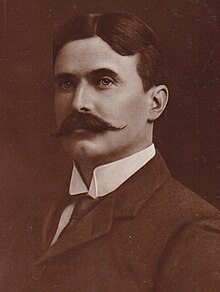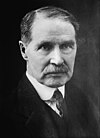William Peel, 1st Earl Peel
This article's lead section may be too short to adequately summarize the key points. (November 2019) |
The Earl Peel | |
|---|---|
 Peel in 1910 | |
| Lord Keeper of the Privy Seal | |
| In office 3 September 1931 – 5 November 1931 | |
| Monarch | George V |
| Prime Minister | Ramsay MacDonald |
| Preceded by | Tom Johnston |
| Succeeded by | The Viscount Snowden |
| Secretary of State for India | |
| In office 18 October 1928 – 4 June 1929 | |
| Monarch | George V |
| Prime Minister | Stanley Baldwin |
| Preceded by | The Earl of Birkenhead |
| Succeeded by | William Wedgwood Benn |
| In office 19 March 1922 – 22 January 1924 | |
| Monarch | George V |
| Prime Minister | David Lloyd George Bonar Law Stanley Baldwin |
| Preceded by | Edwin Montagu |
| Succeeded by | The Lord Olivier |
| First Commissioner of Works | |
| In office 10 November 1924 – 18 October 1928 | |
| Monarch | George V |
| Prime Minister | Stanley Baldwin |
| Preceded by | Fred Jowett |
| Succeeded by | The Marquess of Londonderry |
| Minister of Transport | |
| In office 7 November 1921 – 12 April 1922 | |
| Monarch | George V |
| Prime Minister | David Lloyd George |
| Preceded by | Eric Geddes |
| Succeeded by | The Earl of Crawford |
| Chancellor of the Duchy of Lancaster | |
| In office 1 April 1921 – 19 March 1922 | |
| Monarch | George V |
| Prime Minister | David Lloyd George |
| Preceded by | The Earl of Crawford |
| Succeeded by | William Sutherland |
| Parliamentary Under-Secretary of State for War | |
| In office 10 January 1919 – 1 April 1921 | |
| Monarch | George V |
| Prime Minister | David Lloyd George |
| Preceded by | Ian Macpherson |
| Succeeded by | Robert Sanders |
| Parliamentary Secretary to the Ministry of National Service | |
| In office 15 April 1918 – 10 January 1919 | |
| Monarch | George V |
| Prime Minister | David Lloyd George |
| Preceded by | Cecil Beck |
| Succeeded by | Position abolished |
| Member of the House of Lords Lord Temporal | |
| In office 24 October 1912 – 28 September 1937 Hereditary peerage | |
| Preceded by | The 1st Viscount Peel |
| Succeeded by | The 2nd Earl Peel |
| Member of Parliament for Taunton | |
| In office 23 February 1909 – 24 October 1912 | |
| Preceded by | Sir Edward Boyle |
| Succeeded by | Gilbert Wills |
| Member of Parliament for Manchester South | |
| In office 29 May 1900 – 8 February 1906 | |
| Preceded by | John Campbell |
| Succeeded by | Arthur Haworth |
| Personal details | |
| Born | 7 January 1867 London |
| Died | 28 September 1937 (aged 70) East Meon, near Petersfield, Hampshire |
| Nationality | British |
| Political party | Liberal Unionist Conservative |
| Spouse(s) | Hon. Eleanor Williamson |
| Alma mater | Balliol College, Oxford |

William Robert Wellesley Peel, 1st Earl Peel, GCSI, GBE, TD, PC (7 January 1867 – 28 September 1937), known as The Viscount Peel from 1912 to 1929, was a British politician.
Background and education[]
The eldest son of Arthur Peel, 1st Viscount Peel, and Adelaide Dugdale, Peel was born in London in 1867. His father was the fifth and youngest son of Prime Minister Sir Robert Peel.[1]
He was educated at Harrow and Balliol College, Oxford,[2] where he was secretary of the Oxford Union.[1]
In 1893, he was called to the bar at the Inner Temple, and practised as a barrister before taking the position of special correspondent for the Daily Telegraph during the Greco-Turkish War of 1897.[2][1]
Political career[]
In 1900 Peel was appointed a member of the Royal Commission formed to inquire into the operation of the Port of London. In February the same year he began his political career when he was elected in a by-election to fill a vacant seat for Woolwich in the London County Council,[3] to which he was re-elected in the ordinary election the following year. He was a member of the pro-Conservative grouping on the council that became the Municipal Reform Party. He was leader of the Party from 1908 to 1910, and chairman of the county council from 1914 to 1916.[2][1]
He begun his Parliamentary career when he was elected as Liberal Unionist MP for Manchester South at a . At the next general election in 1906 he stood unsuccessfully at Harrow. He returned to the Commons in 1909, when elected as Conservative MP for Taunton at a by-election.[1] He inherited his father's viscountcy in 1912, and moved to the House of Lords.
Peel was appointed a Deputy lieutenant of Bedfordshire[4] and lieutenant-colonel of the Bedfordshire Yeomanry in 1912, and on the outbreak of the First World War moved to France with his regiment. Due to ill health he returned to Britain in 1915. In 1918 he received his first government post as Joint Parliamentary Secretary at the Department of National Service. In 1919 he became Under-Secretary of State for War and a member of the Privy Council.[2][1] Two years later he became Chancellor of the Duchy of Lancaster and Minister for Transport.
He entered the cabinet in 1922 as Secretary of State for India as part of the coalition government of David Lloyd George but continued in the post after the downfall of the Coalition during the premierships of Bonar Law and Baldwin. Baldwin's Government fell in January 1924, but after a brief spell in opposition was returned to power at the 1924 General Election. Peel was appointed First Commissioner of Works in the Conservative administration formed by Stanley Baldwin. In 1928 he briefly returned to the India Office before the Conservatives lost power at 1929 general election.[1]
The latter year he was created Viscount Clanfield, of Clanfield in the County of Southampton, and Earl Peel in the Dissolution Honours.[2] When a Conservative-dominated National Government was formed after the 1931 election he became Lord Privy Seal. He only held this office for two months, leaving government in November.[1]
In 1932 he was appointed chairman of the , and in 1934 chaired the Royal Commission on the Common Law. In 1936–37, he chaired the Peel Commission which recommended for the first time the partition of the British Mandate of Palestine into separate Jewish and Arab states.[1]
Family[]
Lord Peel married the Hon. Eleanor, daughter of James Williamson, 1st Baron Ashton, in 1899. They had two children: Arthur Peel, 2nd Earl Peel and Lady Doris, who married Col Stewart Blacker.
In 1929, Lord Ashton died and Peel succeeded him as chairman of James Williamson and Company. He was a director of Barclays Bank and of the Great Northern Railway.[2][1]
Death[]
Lord Peel died, aged 70, at his home in East Meon, near Petersfield, Hampshire, in 1937 after a long illness.[2][1] He was succeeded in his titles by his son, Arthur.
References[]
Leigh Rayment's Historical List of MPs
- ^ Jump up to: a b c d e f g h i j k Alex May (2004). "Peel, William Robert Wellesley, first Earl Peel (1867–1937)". Oxford Dictionary of National Biography. Oxford University Press. Retrieved 12 October 2008.
- ^ Jump up to: a b c d e f g Lord Peel, Family Tradition Of Statesmanship, The Times, 30 September 1937, p. 14
- ^ "London County Council election at Woolwich". The Times (36075). London. 26 February 1900. p. 7.
- ^ "No. 28638". The London Gazette. 23 August 1912. p. 6288.
External links[]
- Hansard 1803–2005: contributions in Parliament by the Earl Peel
- 1867 births
- 1937 deaths
- People educated at Harrow School
- Alumni of Balliol College, Oxford
- Earls in the Peerage of the United Kingdom
- Knights Grand Commander of the Order of the Star of India
- Knights Grand Cross of the Order of the British Empire
- Lords Privy Seal
- Members of London County Council
- Members of the Privy Council of the United Kingdom
- Liberal Unionist Party MPs for English constituencies
- UK MPs 1900–1906
- UK MPs 1906–1910
- UK MPs 1910
- UK MPs 1910–1918
- UK MPs who were granted peerages
- UK MPs who inherited peerages
- Deputy Lieutenants of Bedfordshire
- Peel family
- People of the 1936–1939 Arab revolt in Palestine
- Bedfordshire Yeomanry officers
- Conservative Party (UK) MPs for English constituencies
- Members of the Parliament of the United Kingdom for Taunton
- Secretaries of State for Transport (UK)
- People from East Meon
- Peers created by George V
